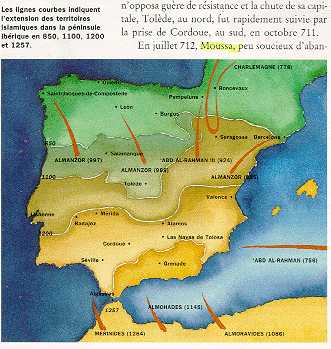THE GREAT ART OF THE ALHAMBRA DE GRANADA
Spain was conquered in 714 A.D. by Muslim armies (after being conquered by,
among others, Romans and Visigoths). During the 800 years until Spain was
reconquered by Christians, the Muslims greatly influenced the culture of
Spain. During the middle ages, when little mathematics and science were
being done in the rest of Europe, Spain was an intellectual center.
The Alhambra is a walled city and fortress in Granada, Spain. It was built
during the last Islamic sultanate on the Iberian peninsula, the Nasrid
Dynasty (1238-1492). The palace is lavishly decorated with stone and wood carvings
and tile patterns on most of the ceilings, walls, and floors. Islamic art does not use
representations of living beings, but heavily uses geometric patterns, especially
symmetric (repeating) patterns.
In this "Medieval-Renaissance" period, Arabic artists excelled in the geometric art of
figrative adornment. The finest example of this is The Alhambra in Grenada (Spain), a
fortess and palace. Mathematicians recognize 128 distinct patterns of "the wallpaper-tile
group". All of these appear in the decorations of The Alhambra (as in an Alhambra portal or an Alhambra relief
or an Alhambra mosaic).
Since 711, with the attack and conquest of the Peninsula, Spain was
under Islamic rule for eight centuries, until 1492, when the Catholic
Monarchs conquerred the last Moslem domain: the Kingdom of Granada.
Al-Andalus, as the Arabian named the conquerred territories in the Iberian
Peninsula, became one of the most important cultural centres in Europe.
The most outstanding Islamic centres in Spain were Cordoba, in the first
place; and then Granada.
The Almohads´s defeat in the battle of Navas de Tolosa in 1212 allowed
the Christians to advance. This fact, apart from splitting the Moslem
supremacy, divided the Islamic power into new Taifas kingdoms of which the
Granada Nazarí one was the most wealthy and powerful since 1238.
Some of the most important artistic works of the Islamic art, which
also constitute the last samples from the Hispano-Moslem art, rose during
their domain. The Alhambra, together with the Generalife gardens, are
undoubtely the most fascinating monumental complex from the Nazarí art.
The Alhambra, which was built on the remains of a 11th c. ancient
castle, became then a palace and, later on, a small town where the nazarí
sultans had their residence. The Alhambra stands on the highest point of
the Sabíka Hill, which rises on the left bank of the Darro river. The
charming Albaycín Citadel, from the Zirí period, is opposite to the
Alhambra.
The Alhambra name comes from the reddish colour of the walls of a
previous castle, already mentioned in the Arabian chronicles of 889. The
existence of a "red castle" on the Sabika Hill allows scholars to date its
antiquity. According to the 12th c. chronicles, the Nazarí resistance used
the Alhambra as a refuge from both the Almoravids and the Almohads. It is
quite probable that the last ones dismantled the old citadel when the
different revolts had been put down.
Alhambra is the most important work of art dating from the last Islamic
sultanate in the Iberian Peninsula. The Nasrid Dynasty (1238 - 1492), who
was responsible for the building of the Palace, combined artistic and
cultural activities with their constant policy of military campaigns and
pacts, thus maintaining a strong united Statc.
Within the
long tradition of Hispano-Muslim art, the Nasrids represent the
culmination of the evolution of Islamic culture in Europe wich at the time
was more advanced than that of their feudal Christian enemies. The
Alhambra of Granada is the most characteristic example of Nasrid art,
which is the high point of the periods of the Emirate, the Caliphate of
Cordoba, the Alhambra is one of the most widelyknown of all Islamic works
of art.
The Nasrid
Sultans chose as the site for their court the Sabika hill, one of
the foothills of Sierra Nevada on the plain of Granada, which constituted
an excellent site from which to keep watch over the capital of their
kingdom and the surrounding area. From the beginning of the XIII century,
the small older buildings, mainly watchtowers, some of which dated back to
before the XI century, gradually grew into a huge walled site which
clearly intended to be both palace and court.
Within this
gradual change, different stages of development, grandeur and decadence
can clearly be seen through the various works of art and buildings erected
over the years. The Albambra was not a single static construction, built
at a specific date, but rather the result of an evolution, successive
reforms and extensions.
Its buildings
are divided into four main different, though not independent
areas.
The
Alcazaba, i. e. the military fortress, built on the oldest site of
the alhambra, was soon put to purely military use since it was situated on
the highest part of the hill, watching over the surrounding
area.
The
Medina, created to house craftsmen and serve the needs of the court,
has the layout of a town in miniature. It occupies the largest part of the
walled area, situated within the so-called "Upper Alhambra", and still
conserves the ruins of several houses, baths and small workshops on its
typical alleys and squares.
The Palaces
are independent from each other, and maintain a slight hierarchy. To date,
five palaces which belonged to the sultan (the Partal, Isma'il I, Comares,
leones and Yusuf III) all within an area clearly set aside for palaces,
together with at least two others, that of the Abencerrajes and that of
the former Saint Francis' Convent, both within the Medina, have been
identified.Finally, the outlying buildings, designed to be leisure and
supply centres also fulfilled a defensive function. They were to be found
throughout the area surrounding the Alhambra and included the
Generalife, Torres Bermejas and the Palace of the
Alijares, which unfortunately no longer
exists.
One of the
most surprising characteristics of the Alhambra is the way in which its
simple structures were transformed into truly pleasing architectural
jewels by the magnificent decorative work of anonymous craftsmen, and
continue to enthrall and delight those who wee them today. Although the
Alhambra is today devoid of furniture, and most of the rich colours of its
decoration have worn off, we have been left at least the testimony of its
purpose summed up for prosperity by the dynasty's moto, wa la galiba
illa Allah (No one conquers but Allah), which appears so many times
in the decoration of its buildings amidst innumerable religious quotations
and poetic lines, as proof of a spirit alive beyond "mere" material
constructions.
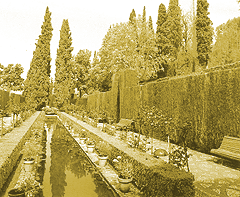
>Appearance of one of the
avenues in the gardens of the
Generalife.
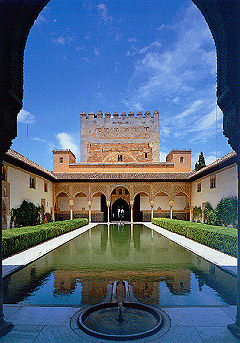
North sight of Comares’ courtyard, in the
Alhambra.
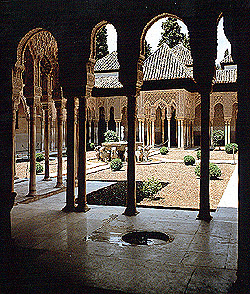
"Los Leones" courtyard in the
Alhambra.
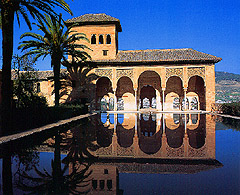
"Torre de
las Damas" in the Partal of the Alhambra. The site formed part of a Nasrid
Palace, dating from the first half of the XIV
century.
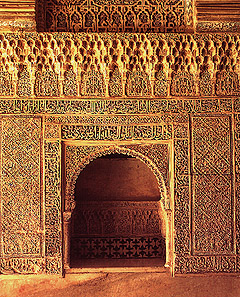
The so called Hall of Comares, in the
Alhambra, was in fact the Throne Hall about the middle of the XIV
century.
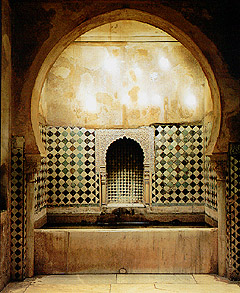
The Baths of the
Alhambra.
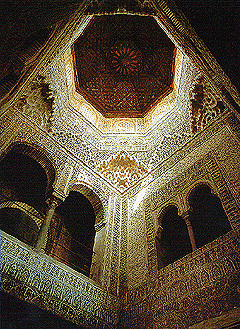
Inside of the "Torre de las Infantas" of
the
Alhambra.
|
- Islamic art uses patterns made of
geometric designs. Complex geometric designs create
the impression of unending repetition, which is believed by some to
represent the infinite (unending in time and space) nature of God. In
religious buildings and palaces, as well as in common objects like bowls and
rugs, the art of Arabic geometric designs is very common.
-
-
A. The star was the most common
Islamic design. In Islamic design, the star is a regular geometric shape that
symbolizes equal radiation in all directions from a central point. All regular
stars -- whether they have 5, 6, 8, 10, 12, or 16 points -- are created by a
division of a circle into equal parts.
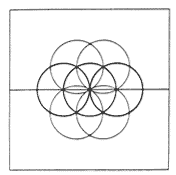
- To see an animated site showing how this star is made, see
the Hyperion Cultural Academy's outstanding "Geometry:
A Study of Islamic Design" site. Be sure to see the
explanation at the bottom of the page which helps you visualize (to see)
the designs! Then return here by pressing your "Back"
button.
-
- Here is an example of a six-pointed star found in a mosque
in Lahore, Pakistan: (Courtesy, UCB Architectural
Library, from Media for the Arts, Newport, RI)

- Eight pointed stars can also be made from two squares turned
at different angles:
 . . .
. . . 
Here are some colorful tiles that show the geometrical
designs that come from two squares - the eight-pointed star.
 Tiles from Andalusia, Muslim Spain (Artopedia.Com)
Tiles from Andalusia, Muslim Spain (Artopedia.Com)
 Tiles from
the Alhambra Palace, Grenada, Andalusia (Muslim Spain).
Tiles from
the Alhambra Palace, Grenada, Andalusia (Muslim Spain).
Here are five-pointed stars
that repeat in patterns based on a square.
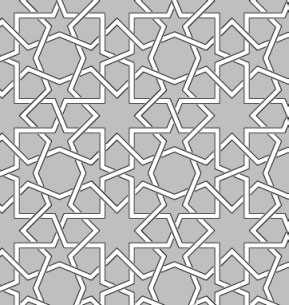
Here are some decorations based on the
twelve-pointed star.
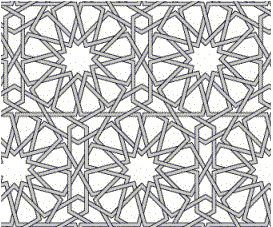

MOSLEM CIVILIZATION IN SPAIN
The ARAB INVASION
History
The Arab occupation in Spain lasted 8 centuries, from 711 to 1492. In
711, TARIQ, an Arab king unload by the Straits of Gibraltar and arrive at the
head of 9000 men. It is by gaining the battle of Guadalete that they manage to
occupy all the Iberian peninsula in a few years. Arab Spain is called Al
Andaluz. A little later, at the beginning of Xème century, Abdérraman III, the
last omayade of Damas arrives to Spain and occupies Cordoue. It establishes a
dynasty which controls Al Andaluz until 1031.
To the death of the Almanzar General in 1002, emerge the small
kingdoms independent to north of the peninsula called "of taiks". Those will
support the reconquest catholique.En 1212, the catholics gain "tired Navas de
Telosa", which overpowers the Moslems. In 1270, all the Moslems are gathered in
the kingdom of Grenade.
Gradually, the catholics manage to push back the Moslems. In 1492,
Isabelle de Castille and Fernando de Aragon succeed in imposing itself. Boabdil
flees and it is the reunification of the Spanish territory.
Various kings
TARIQ IBN ZIYAD: Berber head of origin, it conquered
Spain by crossing the Straits of Gibraltar into 711 and carrying a victory over
king Wisigoth Rodrigue.
ABD AL RAHMAN 1ST. Born into 731, he is the first emir meyyade of Cordoue from 756 to
788. It is into 788 that it dies there.
ABD Al RAHMAN III Born in 890, he is the eighth emir, of 912 until his death into 961.
He is the founder of the Caliphate of Cordoue into 929.
ABU ABD ALLAH or rather BOABDIL is the Moslem king of Grenade under the name of MUHAMMAD XI
by twice. The first time of 1482 to 1483 and the second time of 1486 on 1492, date to which, it
is driven out of its kingdom by the catholic kings.
The Arab contribution.
The Arab occupation during the eight centuries make many progress and leave a large cultural
heritage in addition.
At the cultural level: The Christians and the Arabs used a Hispanic language arabo, which
leaves many Spanish words derived from Arabic. Majority of the Arab words starting with Al. The
Arab language is at that time the international scientific language. They also create many
schools and very famous universities. Also libraries appear, which correctly translates the
cultural significance of this empire.
On the level of the techniques: They improve and facilitate the urban life. It is them which
create the system of égoûts cities. They develop the transportation routes thanks to commercial
main roads which establish a connection between the peninsula and the Red Sea, Méditérranée and
even the Indian Ocean.
The agricultural work is facilitated thanks to the invention of the bucket wheel "noria" which
makes it possible to assemble water in the irrigation canals. They introduce many new plants: the
apricot, the artichoke, rice as well as the cane with sugar.
At the scientific level: Mathematics is of Arab origin since the figures are Arab and are them
which invented the algebra and trigonometry.
If not medicine makes great progress thanks to the surgeon Al Zahrawi who lived Moslem Spain
and which invents many surgical instruments.
Arabic develops the pharmacopeia and the hygiene of life since they found the public baths and
the hammam.
II - HISTORY AND ARCHITECTURE OF THE MOSLEM CITIES
Al Andalus which means the "ground of the Arabic vandals" is called in French Andalusia. It is
at the origin of the zone of Moslem occupation of the Iberian peninsula which extends from
VIIIème century until the end of XVème century and which, finally, included/understood most of
the Spanish territory. The extension of the Islamic state called Al Andalus as many varied as the
borders changed, Moslems as of castillans aragonais advanced as a conqueror the territory.
Today, at the dawn of the 21st century, i.e. almost 600 years after the Arab conquests, it
remains in Spain many monuments representative of the Muslim art primarily located in the towns
of Grenade, Cordoue and Seville.
Grenade
History
Grenade is located in Spain Méridionale, in Andalusia, with the foot of the Névada Sierra. The
town of Grenade was founded into 756 by the Arabs. After having belonged to the caliphate of
Cordoue, it became in XIIIème century the capital of the Moslem kingdom of Grenade. It then knew
the brilliant civilization to which still its monuments testify. In 1492, it was taken again by
the catholic kings who marked the completion of the reconquest thus.
Alhambra
|
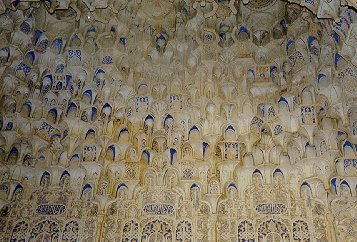
a detail of one of the rooms of
reception of Alhambra |
Alhambra starts to be built in 1238 by the kings nazaris
whose king Yusuf Ier and was increased then by mohames V which finishes
the work in 1358. Boabdil was the last one going down from the dynasty
founded at the beginning of XIIIème century.
Grenade was conquered only in 1492 and constitutes one of
the cities most marked by the Muslim art. Its Arab palate which overhangs
Grenade is one of the principal traces left by the conquest of Arabic.
Alhambra which means "the Red" was built on a very fertile hill from where
its reddish color. This very famous palate was built has course of XIVème
century. Top of the Arab district of Albacin, one can contemplate this
imposing fortress surrounded by a multitude of trees, néammoins sad
because it misses the decorative ones. Indeed, the Moslems did not want to
show their great richness with the conquerors and and thus richly
decorated the interior of the palate which is made up many rooms, run and
of a splendid garden. |
The Patio of Camarès is characterized by its
rectangular water part, bordered of myrtles. At the two ends gantries with 7
arcs of semicircular arch are drawn up. The windows and the arcades of the first
stage present the same traditional profile which gives to the unit a great
purity of line. The Patio of the Lions was built in 1377, thus named because of
its central basin carried by 12 marble lions. All the walls are panelled of
earthenware and are covered with engraved stuccos.
At the interior, the ornamentation of the walls is of a
smoothness, a precision and an exquisite taste. The sculpture on plaster is
marvelously engraved. The ceramics panels azulejos (enamelled earthenware
squares) are sometimes with gilded gloss. Among the most beautiful rooms, the
room of Barca which has a ceiling careens some out of wood of cedar.
The room of the Ambassadors, with the cupola out of
wooden of carved cedar very thoroughly. The Room of Abencérages where one can
admire a splendid cupola whose spangled octagone is all bruissant of a hive of
mourgamas. The Room of the Kings, with the arcs and the cupolas in hemispheres
with stalactiles. The Room of the two sisters to the cupola with mouganas and
the decoration of engraved stuccos and azulejos, etc...
Alcazaba is the fortress built in XIIIème century by
Mohammed In Nour, it is the oldest part of Alhambra. Formerly, it counted 24
towers connected by courtines.El generalif, the garden is characterized by
pretty flowers, fountains, its benches and its labyrinth.
Alhambra is thus the monument emblematic of the town of
Grenade and of many visitors since years are filled with enthusiasm and cannot
prevent oneself from dreaming in front of prestige and the grace of the Islamic
culture.
CORDOVAThe town of Cordoue is also located in Spain Méridionale, Andalusia and
on the river of Guadalquivir.
History
Of Carthaginoise origin, it became one of the principal towns of Spain. Fallen in decline under
the Visigoths, she knew thanks to Arabic who seized some into 711 an incomparable glare. The
emirate of Cordoue, founded in 756 by Abd Al Rahman Ier extended its authority on all Spain
Musulmane. In Xème century, the emirate became a brilliant caliphate. From XIème century, the
caliphate was divided into small kingdoms and Cordoue was reconquered by Ferdinand III in 1236.
The most famous monument of the city is the "mosque" founded by Abd Al Rahman Ier increased by
Abd alRahman II. This Large Mosque was transformed into cathedral by Charles Quint.. Founded by
Abd Al Rahman Ier into 785-788. His/her Heicham son 1st who completed work added a minaret. The
Mosque took again the plan of mosque Al Agsa of Jerusalem, with the naves perpendicular to Gibla
and broad central vessel. It counted 11 naves and 1 court. The vertical cut followed the example
of the Large mosque of Damas with 2 stages of superimposed columns. The arcs however are out of
horseshoe, constant tradition in the art Visigoth but which also existed in the East, from where
it came at the origin. The alternate archstones are typically byzantins.
Abd Al Rahman II increases the mosque between 833 and 848 by adding 8 spans to the room of the
prayers which preserved the same width and the same number of naves. It made also surround the
court of gantries. One imitated exactly the ordinance of the superimposed colonnades. Abd Al
Rahman III equipped the mosque with a large minaret into 951. It was square like the first with
the image of the Syrian bell-towers, but much higher. Then Al hakam II still lengthened the
mosque of 12 spans, i.e. the more so as the first mosque of Abd Al Rahman. It preserved the same
ordinance of the naves. The other cupola is in front of the mirhab and others nervées frame it.
The arcades under these cupolas are made of intersected and entirely carved lobed arcs. They give
a character particular to all the part in front of the mirhab, by constituting a kind of
magsoura.. Moreover all the circumference of the mirhab was decorated splendid mosaic bysantines
of glass, gold and dark blue. The mosaiques ones surmounted also the door of the imam and minbar
carries it. The sculptures of the side cupolas in front of these doors were gilded.
The mirhab itself is single in its kind. It constitutes true a room derrrière her arc
surrounded by mosaic. It is decorated carved marble flagstones, engraved and gilded stuccos and
more beautiful columns of jasper and marble. Alas all this splendour was destroyed by the Berber
ones in 1013 and thereafter. The palates were used as career, with the result that there remain
about it nothing any more. However, one found a great number of carved panels and capitals and
one starts to rebuild a room of the palace.









 . . .
. . . 
 Tiles from Andalusia, Muslim Spain (Artopedia.Com)
Tiles from Andalusia, Muslim Spain (Artopedia.Com) Tiles from
the Alhambra Palace, Grenada, Andalusia (Muslim Spain).
Tiles from
the Alhambra Palace, Grenada, Andalusia (Muslim Spain).



